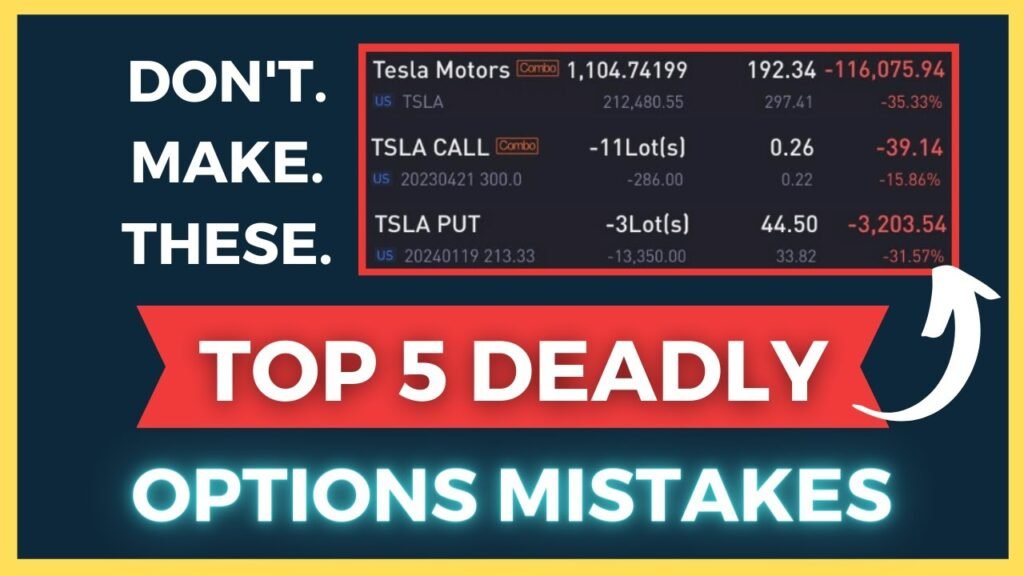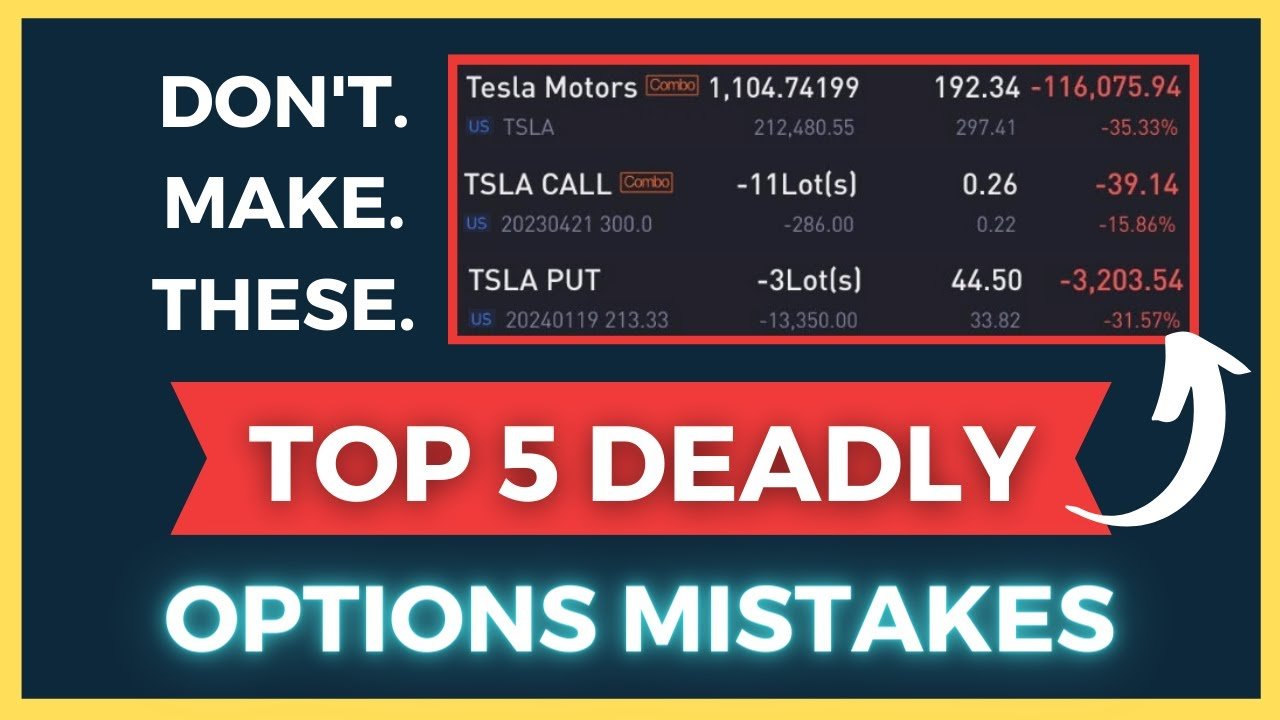Are you a beginner in option trading? If so, then you definitely want to avoid these top 5 mistakes at all costs. In the video titled “Top 5 Option Trading Beginner Mistakes To Avoid At All Costs” by Options with Davis, you will find valuable information on how to avoid common pitfalls in option trading. The video emphasizes the importance of steering clear of these mistakes in order to achieve consistent profitability in options trading. It also mentions a free resource called “The Options Income Blueprint” which can provide further guidance. Additionally, the video suggests exploring other related videos on the channel. So, if you’re looking to improve your option trading skills, make sure to check out this informative video and avoid these costly mistakes.
High-Probability Consistent Income Strategies
As a beginner in option trading, it’s important to understand the difference between selling premium and buying premium. Selling premium involves taking a position where you receive premium, while buying premium involves paying for the option. In this article, we will explore the benefits of selling premium in option trading and how it can lead to consistent income.
Selling premium vs buying premium
When it comes to option trading, many beginners make the mistake of buying premium instead of selling premium. While there are certain scenarios where buying premium can be profitable, it’s important to understand that buying premium trades are generally directional trades. This means that you need to be right on the direction in order to make a profit. This can be quite challenging, as predicting market direction accurately is not easy.
On the other hand, selling premium trades do not require you to be exactly right on the direction. Instead, you just need to avoid being very wrong on the direction. Selling premium gives you the advantage of theta or time decay, which works in your favor. With each passing day, the value of the options you sold will decay, leading to potential profits even without a significant move in the underlying asset.
Benefits of selling premium in option trading
One of the main benefits of selling premium in option trading is the higher probability of profitability compared to buying premium trades. Selling premium trades typically have a higher win rate, meaning you have a higher chance of making a profit. This is because you are taking advantage of theta decay, which helps generate consistent income over time.
Another advantage of selling premium is the reduced risk compared to buying premium. When you sell premium, you have limited risk, which is defined by the strike prices of the options you sold. Even if the underlying asset moves against your trade, as long as it doesn’t go beyond your short strike at expiration, you can still be profitable.
Furthermore, selling premium allows you to take advantage of different option strategies, such as credit spreads. Credit spreads involve selling one option and buying another option with a different strike price, resulting in a net credit. This strategy allows you to construct trades with a high probability of profit, as you are not solely relying on market direction.
By focusing on selling premium and utilizing different option strategies, you can increase your chances of generating a consistent income in option trading. It’s important to note that selling premium does not guarantee profits in every trade, but it provides a higher probability of success compared to buying premium.
Recurring Profits With The Wheel Strategy
The “Wheel Strategy” is an income generation strategy that allows traders to potentially generate recurring profits by capitalizing on the movement of an underlying asset within a defined range. It involves a series of trades that aim to take advantage of both upward and downward price movements.
Introduction to the ‘Income Grid’ Wheel Strategy
The Wheel Strategy is often referred to as the “Income Grid” strategy due to its ability to generate consistent income. The strategy involves three key components: selling cash-secured puts, holding the underlying asset if assigned, and selling covered calls.
To implement the Wheel Strategy, you start by selling cash-secured puts on an underlying asset you are willing to own. If the option is exercised, you are obligated to buy the asset at the strike price. However, if the option expires worthless, you keep the premium received as profit.
If you are assigned the shares, you then hold the asset and can potentially collect dividends or sell covered calls against the shares. Selling covered calls involves selling call options on the shares you own, allowing you to collect premium if the options are not exercised. This can provide additional income while you hold the shares.
The Wheel Strategy is a dynamic strategy that allows you to continuously generate income through the cycle of selling puts, holding shares, and selling covered calls. It provides a systematic approach to capturing income from an underlying asset while managing risk.
Advantages of the Wheel Strategy
One of the key advantages of the Wheel Strategy is that it allows traders to generate recurring income from an underlying asset. By selling cash-secured puts and potentially being assigned the shares, you can profit from both upward and downward price movements. This can help to smooth out market fluctuations and provide a consistent income stream.
Another advantage of the Wheel Strategy is that it allows traders to potentially generate income even in sideways or slightly downward trending markets. By using the income generated from selling covered calls, you can offset any potential loss on the underlying asset. This makes the strategy versatile and suitable for different market conditions.
Additionally, the Wheel Strategy provides a systematic approach to trading. It helps traders stay disciplined and avoid impulsive decisions based on emotions. By following a defined set of rules and consistently executing the strategy, traders can remove emotions from the equation and focus on generating consistent profits.
Overall, the Wheel Strategy offers traders the potential for recurring profits by utilizing a combination of selling cash-secured puts and covered calls. It provides a structured approach to income generation and can be an effective strategy for traders looking to capitalize on the movement of an underlying asset.

Mastering Covered Calls
Covered calls are a popular option strategy that involves selling call options on an underlying asset you already own. By selling covered calls, you can generate income from the premium received while still holding the shares. In this section, we will explore the process of selecting covered calls and the benefits of utilizing this strategy.
Guide to selecting covered calls in option trading
When selecting covered calls, it’s important to consider a few key factors. The first is the strike price of the call option. It’s generally recommended to select a strike price that is slightly above the current market price of the underlying asset. This allows for potential upside if the price increases but also provides a buffer in case the price remains stagnant or slightly decreases.
Another factor to consider is the expiration date of the call option. It’s often recommended to select a shorter expiration date, such as 30-45 days, to take advantage of time decay. This means that the option will lose value as it approaches expiration, allowing you to keep the premium received as profit if the option is not exercised.
Additionally, it’s important to assess the implied volatility of the options you are considering. Higher implied volatility generally leads to higher option premiums, providing more income potential. However, it’s important to strike a balance between high premiums and the risk associated with higher volatility.
Lastly, it’s crucial to assess the overall risk-reward profile of the trade. Consider the potential profit from the premium received compared to the risk of potential assignment and the opportunity cost of holding the shares instead of selling them outright. This analysis can help you determine whether a specific covered call trade aligns with your trading objectives.
Benefits of utilizing covered calls
One of the main benefits of utilizing covered calls is the ability to generate income from existing shares. By selling call options, you effectively rent out your shares and collect premium as income. This can be particularly useful in a sideways or slightly bullish market where the underlying asset is not expected to have significant price movements.
Another benefit of covered calls is the potential to enhance returns on a stock position. If the underlying asset experiences a price increase, you can profit from the premium received and still participate in the upside potential up to the strike price of the call option. This allows you to potentially outperform a simple buy-and-hold strategy.
Furthermore, covered calls provide a level of downside protection. The premium received from selling the call option acts as a cushion against potential losses in the underlying asset. While this does not eliminate the risk entirely, it can mitigate the impact of a price decline.
Lastly, covered calls can be a useful strategy for managing positions that have already generated substantial gains. By selling covered calls, you can potentially lock in profits and generate additional income while still holding the shares. This allows you to actively manage your portfolio and adapt to changing market conditions.
In conclusion, mastering covered calls can be a valuable skill for option traders. By selecting the right options and effectively managing your positions, you can generate income, enhance returns, and manage risk in your trading portfolio.
